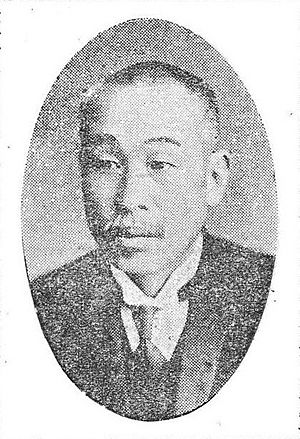Lee Kyu-wan facts for kids
Quick facts for kids
Lee Kyu-wan
|
|
|---|---|

Lee Kyu-wan, 1930
|
|
| Born | November 15, 1862 |
| Died | December 15, 1946 (aged 84) |
| Nationality | Korean |
| Other names | Japanese: Asada Ryo (아사다 료, 淺田良), Asada Ryoichi (아사다 료이치, 淺田良一) |
| Occupation | politician, philosopher, revolutionist |
| Known for | revolutionist during Korea's Joseon period |
| Children | Lee Sun-kil (이선길;李鮮吉), judoka, Lee Young-il (이영일;李英一), painter and teacher |
Lee Kyu-wan (이규완 李圭完; November 15, 1862 - December 15, 1946) was an important person in Korea during the Joseon period. He was a politician, a thinker (philosopher), and someone who wanted big changes (a revolutionist). He also had Japanese names: Asada Ryo and Asada Ryoichi. In 1884, he was part of a quick attempt to change the government called the Gapsin Coup. This event tried to overthrow the royal palace in Seoul with some support from Japan.
Contents
Lee Kyu-wan's Early Life
Lee Kyu-wan was born in Gwangju, a city in Gyeonggi Province, Korea. His family had a connection to the royal family of the Joseon Dynasty. He was a descendant of Prince Limyoung, who was the fifth son of a famous king, Sejong the Great.
Lee's childhood was a bit challenging. His father worked as a woodcutter and was moving to Seoul. Sadly, his mother passed away when he was young, and his father remarried.
Becoming a Reformer
As a young man, Lee Kyu-wan was inspired by politicians who wanted to make Korea more modern. These leaders were Park Young-hyo and Seo Jae-pil. They helped him go to Japan to study in 1883. This trip was important for his ideas about changing Korea.
In 1884, he came back to Korea. He was given a junior role in the military.
The Gapsin Coup and Its Aftermath
In December 1884, Lee Kyu-wan became one of the military leaders in the Gapsin Coup. This was a short attempt to take control of the government. When the coup failed, Lee had to escape to Yamaguchi, Japan.
Life in Japan
Lee spent a long time moving around in Japan. He lived in places like Yamaguchi, Shimonoseki, and Fukuoka. For much of this time, he worked in a silk factory and a rice mill. These businesses were owned by the Nakamura family. A member of this family, Nakamura Ichi, was a diplomat for the United States in Japan.
On July 15, 1896, Lee Kyu-wan married Nakamura Umeko, who was Nakamura Ichi's daughter.
Returning to Korea
In 1894, Lee Kyu-wan was forgiven for his past actions and was able to return to Korea. However, the very next year, he was thought to be involved in another attempt to change the government, led by Park Young-hyo. Both of them had to escape again.
Later Roles and Values
Lee Kyu-wan stayed in Japan for a while. In 1907, he was appointed as a deputy director of a forestry office. In July 1907, he was pardoned again and returned to Korea for good. He was given an important government position.
In 1908, he became the governor of Gangwon Province. He continued in this role even after Korea came under Japanese rule in 1910. In 1918, he became the governor of South Hamgyong Province. He resigned from this role seven years later.
In his older years, Lee Kyu-wan focused on farming and making unused land useful. He also did a lot of charity work. He believed strongly in being hardworking and saving money. He did not like people who were lazy or did not have jobs.
His Family
Lee Kyu-wan had two sons. His first son, Lee Sun-kil, became a famous judoka (someone who practices judo) and an educator in Korea. His other son, Lee Young-il, was a painter and a middle school teacher.
See also
- Gapsin coup
- Seo Jae-pil
- Park Young-hyo
- Yun Chi-ho
- Kim Ok-gyun

